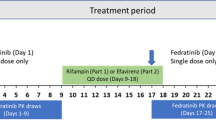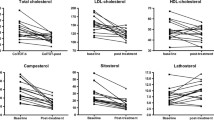Abstract
Objective and methods
A member of the major human cytochrome P450 superfamily of hemoproteins, CYP3A4/5, converts cholesterol into 4β-hydroxycholesterol. We studied plasma 4β-hydroxycholesterol levels prior to and 4 weeks after initiating antiretroviral therapy that included efavirenz, ritonavir-boosted atazanavir or ritonavir-boosted lopinavir with the aim of exploring the usefulness of plasma 4β-hydroxycholesterol levels as an endogenous biomarker of CYP3A activity. Efavirenz is an inducer of CYP3A, whereas the ritonavir-boosted regimens are net inhibitors of CYP3A.
Results
In patients treated with efavirenz, the median plasma 4β-hydroxycholesterol level increased by 46 ng/mL (p = 0.004; n = 11). In contast, patients given ritonavir-boosted atazanavir showed a median decrease in plasma 4β-hydroxycholesterol of −9.4 ng/mL (p = 0.0003; n = 22), and those given ritonavir-boosted lopinavir showed a median change from baseline of –5.8 ng/mL (p = 0.38; n = 19). There were significant between-group differences in the effects of antiretroviral treatment on plasma 4β-hydroxycholesterol levels (p < 0.0001).
Conclusion
Changes in plasma 4β-hydroxycholesterol following the initiation of efavirenz- or atazanavir/ritonavir-based antiretroviral therapy reflected the respective net increase and decrease of CYP3A activity of these regimens. The plasma 4β-hydroxycholesterol level did not indicate a net CYP3A inhibition in the lopinavir/ritonavir arm, possibly because of concomitant enzyme induction.


Similar content being viewed by others
References
Breuer O (1995) Identification and quantitation of cholest-5-ene-3 beta,4 beta-diol in rat liver and human plasma. J Lipid Res 36:2275–2281
Bodin K, Bretillon L, Aden Y, Bertilsson L, Broome U, Einarsson C et al (2001) Antiepileptic drugs increase plasma levels of 4beta-hydroxycholesterol in humans: evidence for involvement of cytochrome p450 3A4. J Biol Chem 276:38685–38689
Breuer O, Dzeletovic S, Lund E, Diczfalusy U (1996) The oxysterols cholest-5-ene-3 beta,4 alpha-diol,cholest-5-ene-3 beta,4 beta-diol and cholestane-3 beta,5 alpha,6 alpha-triol are formed during in vitro oxidation of low density lipoprotein, and are present in human atherosclerotic plaques. Biochim Biophys Acta 1302:145–152
Bodin K, Andersson U, Rystedt E, Ellis E, Norlin M, Pikuleva I et al (2002) Metabolism of 4 beta -hydroxycholesterol in humans. J Biol Chem 277:31534–31540
Diczfalusy U, Miura J, Roh HK, Mirghani RA, Sayi J, Larsson H et al (2008) 4beta-hydroxycholesterol is a new endogenous CYP3A marker: relationship to CYP3A5 genotype, quinine 3-hydroxylation and sex in Koreans, Swedes and Tanzanians. Pharmacogenet Genomics 18:201–208
Mouly S, Lown KS, Kornhauser D, Joseph JL, Fiske WD, Benedek IH et al (2002) Hepatic but not intestinal CYP3A4 displays dose-dependent induction by efavirenz in humans. Clin Pharmacol Ther 72:1–9
Sustiva SPC, Bristol-Myers Squibb (2007) Available at: http://www.emea.europa.eu/humandocs/PDFs/EPAR/Sustiva/H-249-PI-en.pdf. Accessed 12 Aug 2007
Hsu A, Granneman GR, Bertz RJ (1998) Ritonavir. Clinical pharmacokinetics and interactions with other anti-HIV agents. Clin Pharmacokinet 35:275–291
Norvir SPC, Abbott (2007) Available at: http://www.emea.europa.eu/humandocs/PDFs/EPAR/Norvir/H-127-PI-en.pdf. Accessed 12 August 2007
Reyataz SPC, Bristol-Myers Squibb (2007) Available at: http://www.emea.europa.eu/humandocs/PDFs/EPAR/reyataz/H-494-PI-en.pdf. Accessed 12 Aug 2007
Yeh RF, Gaver VE, Patterson KB, Rezk NL, Baxter-Meheux F, Blake MJ et al (2006) Lopinavir/ritonavir induces the hepatic activity of cytochrome P450 enzymes CYP2C9, CYP2C19, and CYP1A2 but inhibits the hepatic and intestinal activity of CYP3A as measured by a phenotyping drug cocktail in healthy volunteers. J Acquir Immune Defic Syndr 42:52–60
Shikuma CM, Yang Y, Glesby MJ, Meyer WA 3rd, Tashima KT, Ribaudo HJ et al (2007) Metabolic effects of protease inhibitor-sparing antiretroviral regimens given as initial treatment of HIV-1 Infection (AIDS Clinical Trials Group Study A5095). J Acquir Immune Defic Syndr 44:540–550
Kaletra SPC, Abbott (2007) Available at: http://www.emea.europa.eu/humandocs/PDFs/EPAR/kaletra/H-368-PI-en.pdf. Accessed at 12 Aug 2007
Malan N, Kranz E, David N, Kastango K, Frederick D, Matthew M et al (2006) Efficacy and safety of atazanavir-based therapy in antiretroviral naive HIV-1 infected subjects, both with and without ritonavir: 48-week results form AI424–089 (abstract no.107LB). In: 13th Conf Retroviruses Opportunistic Infections. Denver, CO.
Galteau MM, Shamsa F (2003) Urinary 6beta-hydroxycortisol: a validated test for evaluating drug induction or drug inhibition mediated through CYP3A in humans and in animals. Eur J Clin Pharmacol 59:713–733
Kaletra, Scientific Discussion. Abbott (2007) Available at: http://www.emea.europa.eu/humandocs/PDFs/EPAR/kaletra/453001en6.pdf. Accessed 12 Aug 2007
Vishnuvardhan D, Moltke LL, Richert C, Greenblatt DJ (2003) Lopinavir: acute exposure inhibits P-glycoprotein; extended exposure induces P-glycoprotein. Aids 17:1092–1094
Anonymous. Study No: APV10018. Available at: http://ctr.gsk.co.uk/Summary/fosamprenavir/studylist.asp. Accessed 12 Aug 2007
Prezista SPC, Janssen Cilag (2007) Available at: http://www.emea.europa.eu/humandocs/PDFs/EPAR/prezista/H-707-PI-en.pdf.. Accessed 12 Aug 2007
van der Lee MJ, Dawood L, ter Hofstede HJ, de Graaff-Teulen MJ, van Ewijk-Beneken Kolmer EW, Caliskan-Yassen N et al (2006) Lopinavir/ritonavir reduces lamotrigine plasma concentrations in healthy subjects. Clin Pharmacol Ther 80:159–168
Burger DM, Huisman A, van Ewijk N, Neisingh H, Rongen G, Koopmans PP et al (2007) The effect of atazanavir and atazanavir/ritonavir on UGT1A4 using lamotrigine as a phenotypic probe (abstract no. 566) In: 14th Conf Retroviruses Opportunistic Infections). Los Angeles, CA
Fromm MF, Schwilden H, Bachmakov I, Konig J, Bremer F, Schuttler J (2007) Impact of the CYP3A5 genotype on midazolam pharmacokinetics and pharmacodynamics during intensive care sedation. Eur J Clin Pharmacol 63:1129–1133
Acknowledgements
This work was supported by grants from Swedish Research Council, Medicine (3902), EDCTP (European & Developing Countries Clinical Trial Partnership, 32030), Magnus Bergwalls stiftelse, ALF-project (560177), and Torsten and Ragnar Söderbergs Foundation.
Author information
Authors and Affiliations
Corresponding author
Rights and permissions
About this article
Cite this article
Josephson, F., Bertilsson, L., Böttiger, Y. et al. CYP3A induction and inhibition by different antiretroviral regimens reflected by changes in plasma 4β-hydroxycholesterol levels. Eur J Clin Pharmacol 64, 775–781 (2008). https://doi.org/10.1007/s00228-008-0492-8
Received:
Accepted:
Published:
Issue Date:
DOI: https://doi.org/10.1007/s00228-008-0492-8




